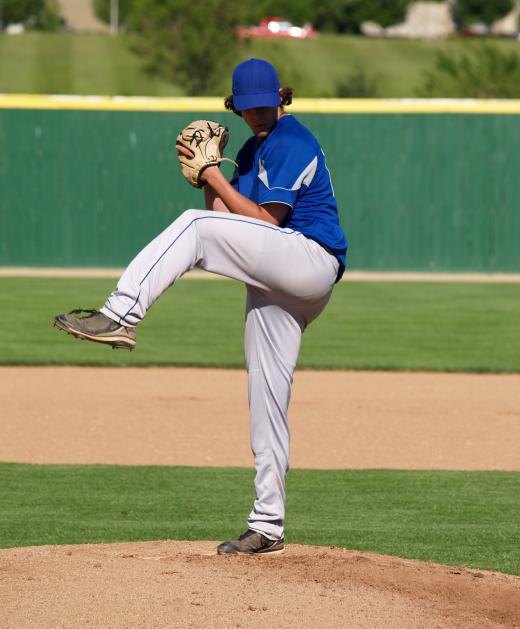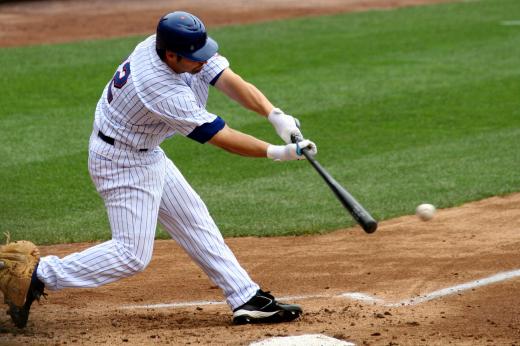At Sports&Hobbies, we're committed to delivering accurate, trustworthy information. Our expert-authored content is rigorously fact-checked and sourced from credible authorities. Discover how we uphold the highest standards in providing you with reliable knowledge.
How Many Ways can a Batter get on Base?
There are seven ways for a batter to reach base safely in baseball:
1. Hit — A hit is the most common way to get on base. The batter hits the ball and makes it to first base without being thrown out. A hit can be anything from a bunt single; to an infield single; to a single, double, triple or home run.
2. Base on balls — The pitcher throws four balls before throwing a third strike and before the ball is put in play in fair territory. The batter is awarded first base.
3. Hit by pitch — The batter is hit by a pitched ball and is awarded first base.

4. Error — The batter hits a ball that should be fielded cleanly for an out, but a defensive miscue allows him to reach first base safely. An error can be made by the person fielding the ball — either in the act of fielding it or the act of throwing to first base — or by the first baseman, if he drops a catchable throw.
5. Fielder's choice — A fielder's choice occurs when a batter reaches first base only because the fielder attempted to get another baserunner out. This is most common when a ground ball is hit with a runner on first base. The defense throws to second base for the force out on the runner coming from first, but the batter makes it to first before the double play can be completed. This does not count as a hit for the batter, even if the runner going to second base makes it safely.

6. Dropped third strike — If, with first base open or with two outs, the batter swings at strike three but the catcher does not catch the ball cleanly, the batter can attempt to run to first base. The catcher must pick up or retrieve the ball and tag the batter or throw him out at first base to complete the strikeout. This counts as an out for the batter and strikeout, and a wild pitch or passed ball for the pitcher and defense.

7. Catcher's interference — If the catcher makes contact in any way with the batter or his bat during the swing, catcher's interference is called and the batter is awarded first base, while the catcher is credited with an error. The most common type of catcher's interference occurs when the catcher sits too close to home plate and the batter hits the glove when swinging at the pitch.
AS FEATURED ON:
AS FEATURED ON:













Discussion Comments
Does a batter have to swing for the dropped third strike rule to be in play? What about called third strikes?
At the upper levels of baseball, called strikes are almost always caught. But at lower levels (like my daughter's 10 and under softball league), it's not at all unusual for called strikes to be dropped. We play that the rule applies to all third strikes, swinging or called.
One thing I find interesting about a batter reaching first base due to an error is that the rule doesn't necessarily account for a speedy runner who "forces" errors by making fielders rush their throws to first base before he reaches safety.
In the case of a slow batter, a fielder can drop the ball and possibly still recover it in time to throw it to first and get the out, but that same fielder might make a bad, rushed throw against the speedy runner and get charged with an error, even though the speedy runner used a skill to get on base that the slow runner did not.
I don't think it's a coincidence that Ichiro Suzuki led the league in reaching base on error in the same year that he led the majors in infield hits.
Wow! I did not know there were so many ways for a batter to get on base in baseball! I of course knew of the most common ones, but not the other ones. I just learned about pitcher interference, dropped third strike, and fielders choice. I love to go to minor league baseball games, so I will pay close attention to see if I notice any of the batters going to first base for any of these reasons.
When I was little, some of the neighborhood children and I would get together and play physical games. We rarely played baseball though, that is possibly why I don't know too much about the sport. We would normally play kickball instead. Kickball seems easier because as far as I know, there aren't as many rules in that game. Plus, all you need for kickball is a ball, which makes it a little easier to play.
I thought of obstruction on the part of the fielder as an additional way a batter could get on base, but then I checked the rules, and it's my understanding of them that the fielder is charged with an error whenever that happens, so it would already be covered by the fourth way outlined in the original article.
The catcher is also charged with an error in the case of catcher's interference, but since baseball actually tracks catcher's interference as a separate stat, I suppose it makes sense to list it as a separate way to get on base as well. Catcher's interference is only called on a team about once per season so it's understandable that not many people are familiar with that one.
@strawCake - I used to play in neighborhood baseball games when I was a kid too. So much fun!
We used to argue over the rules a lot. A few of the kids really knew a lot about baseball, and the rest of everyone just wanted to have fun! In fact, I remember we once had a heated argument about catcher's interference. The team that was batting claimed the catcher interfered and the batter should get to go to first base. Then the other team tried to say catcher's interference wasn't even in the rules.
Well, I'm glad I now know the truth after all these years!
When I was a little kid, my neighbors and I would all get together and play baseball. I believe we observed some of these rules, but I don't think any of knew all the names for them.
My favorite way to get on base was definitely by getting a hit. It's just less fun if you get to go to first base because of an error or something. Plus, if you get a hit, that gives the other players on base a chance to run to the next base or to home too!
There's also the ground rule double. If a batted ball bounces out of play, the batter gets to go to second base. The ball has to land fair (not foul) and then bounce somewhere they can't get to it, like into the dugout, the bullpen, or the stands.
I also heard once on radio trivia that there can be an automatic triple. Supposedly, if a fielder catches the ball in his hat, the batter gets to go to third base. Don't know if that's true! I guess theoretically, if you could save a homerun by using your cap, it would be worthwhile.
Moldova- Sometimes there is an intentional walk. That means that the pitcher of the opposing team decides to let the batter intentionally get on base by throwing four intentional pitches that are so far out of the strike zone that the batter automatically gets on base.
This is a strategic play that normally happens when the batter is really good and has a higher chance of having a base it. These are the batters that tend to have the highest slugging percentages and also have the most runs batted in or R.B.I.’s.
The pitcher does not want to take a chance with this batter and does not let him bat so that he can get to the next batter and strike him out.
I know that in the American League there is a designated hitter that bats for the pitcher that usually comes into the game as a pinch hitter. These players are also great at getting on base and always wait for the right pitch.
I know that pinch hitters are also used to replace other players in the game and come up at bat when the stakes are a little higher and the team is using the pinch hitter to try to get some men on base. I love baseball and really think that the game is exciting to watch.
Pinch run; obstruction; runner interference (scored a hit).
Post your comments